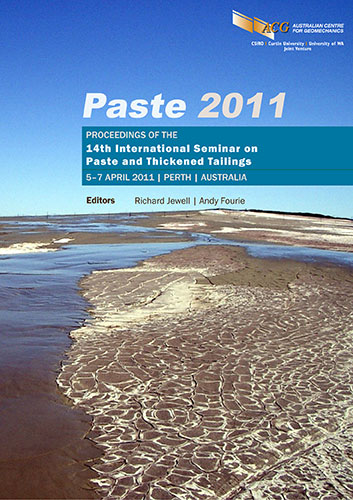A technique for measuring the reduction of yield stress of thickened tailings

|
Authors: Pornillos, EU Paper is not available for download Contact Us |
DOI https://doi.org/10.36487/ACG_rep/1104_16_Pornillos
Cite As:
Pornillos, EU 2011, 'A technique for measuring the reduction of yield stress of thickened tailings', in R Jewell & AB Fourie (eds), Paste 2011: Proceedings of the 14th International Seminar on Paste and Thickened Tailings, Australian Centre for Geomechanics, Perth, pp. 167-174, https://doi.org/10.36487/ACG_rep/1104_16_Pornillos
Abstract:
The need to reduce the yield stress and viscosity of highly dewatered thickened tailings is very important to the design of pumping and transport systems over long distance pipelines to a tailings storage facility. Test work in the laboratory and pilot plant has been conducted to measure the rates of reduction of yield stress of flocculated thickened tailings, in order to determine the relationship between solids content, power consumption, time duration and stirring intensity at 180 and 950 rpm. Highest reduction rates occur during the onset of stirring, rapidly flattening off to approach a limit. Three types of flocculated tailings materials were evaluated. An in-house designed prototype of a simple shear device with data logger was employed to characterise the rheological behaviour of the samples and generated the parameters required for design of large volumetric flows, characteristic of large modern projects in the design stage in South America. Rates of reduction of yield stress were determined for each type of tailings tested. The results will be presented as figures relating the unsheared, sheared and fully sheared samples. Such relationships are necessary in the design of tailings handling downstream of thickeners, such us the agitated receiving tank for thickened tailings, to further enhance the rheology prior to the delivery pump and distribution spigots of a tailings deposition strategy. The findings show how solids contents of the underflows can be handled, having established the yield stress as the tailings are transported to tailings storage.
References:
Figueroa, J.H. and Roman, J. (2009) High density thickening and gravity transportation of Cuajone tailings, in Proceedings 12th International Seminar on Paste and Thickened Tailings (Paste09), R.J. Jewell, A.B. Fourie,
S. Barrera, J. Wiertz (eds), 21–24 April 2009, Viña Del Mar, Chile, Gecamin Limited, Santiago, Australian Centre for Geomechanics, Perth, pp. 185–190.
Luppnow, D., Moreno, J. and Palape, M. (2009) Control and management of thickened tailings beach – a simplified approach, in Proceedings 12th International Seminar on Paste and Thickened Tailings (Paste09), R.J. Jewell, A.B. Fourie, S. Barrera, J. Wiertz (eds), 21–24 April 2009, Viña Del Mar, Chile, Gecamin Limited, Santiago, Australian Centre for Geomechanics, Perth, pp. 245–250.
Pornillos, E., Loayza, C.C. and Cabrejos, J.A. (2009) High density thickened tailings transport by gravity, in Proceedings 12th International Seminar on Paste and Thickened Tailings (Paste09), R.J. Jewell, A.B. Fourie,
S. Barrera, J. Wiertz (eds), 21–24 April 2009, Viña Del Mar, Chile, Gecamin Limited, Santiago, Australian Centre for Geomechanics, Perth, pp. 233–242.
© Copyright 2024, Australian Centre for Geomechanics (ACG), The University of Western Australia. All rights reserved.
View copyright/legal information
Please direct any queries or error reports to repository-acg@uwa.edu.au
View copyright/legal information
Please direct any queries or error reports to repository-acg@uwa.edu.au